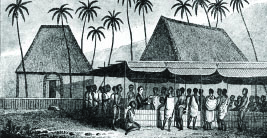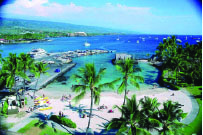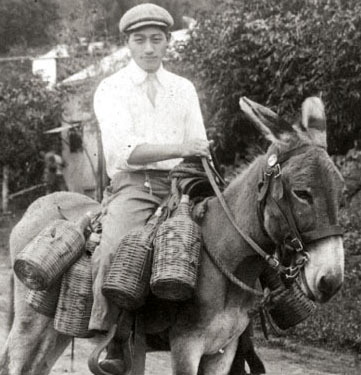
Then & Now: Multi-Cultural Holualoa—The “Long Sled”
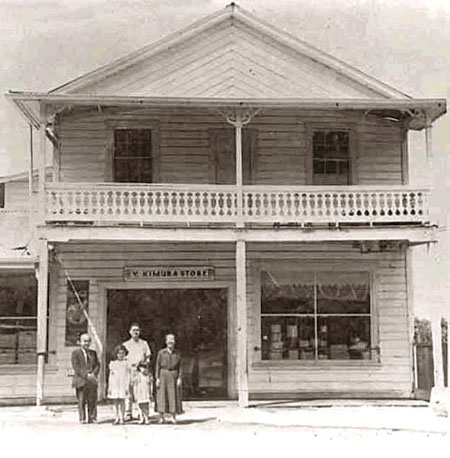
By Ann C. Peterson
When King Kamehameha ruled from Kamakahonu (near today’s Kailua Pier), he would look up to the slopes of Hualalai and know that all was good. This is where he had built Kuahewa, an extensive, dry-land farming miracle that ran three miles wide for 18 miles to the south. In a terraced masterpiece of rich volcanic soil that maximized the scant rainfall and fed the hundreds of thousands living in the region, were lush groves of breadfruit (ulu), mountain apple, and kukui nut trees, blended in with fields of taro, cabbage, yams, and much more. Known today as the Kona Field System, when naturalist Archibald Menzies saw it in 1793, he called it the Eighth Wonder of the World.
At the core of this agricultural haven is Holualoa Village, named after the thrilling, yet dangerous sport of riding a thin “long sled run”, (lit: “holua” or wooden sleds and “loa” for long) down a slope of coarse lava rock pebbles. Today, this swath of fertile soil is part of the Kona Coffee Belt and it reflects the diversity of multi-cultural immigrants who found a new life along the holua run.
With the advent of foreign visitors and ships, the mauka landscape and ethnic mix changed rapidly. In 1828, a European named Samuel Reverend Ruggles introduced coffee to Holualoa with cuttings from Brazil, and during the 1840s, an entrepreneurial effort saw the planting of hundreds of acres of the crop. The industry, however, took a back seat to the crop often called “king” in Hawai‘i—sugar. From 1899 to 1926, sugar reigned in the little village that became Kona’s only sugar town and the district’s vital economic hub.
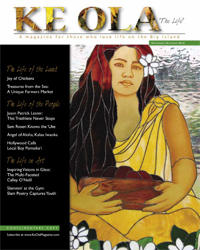
By 1852, most Chinese, Portuguese, Japanese and Filipino immigrants arriving in Hawai‘i came to work in the sugar fields, while some worked the coffee fields. When the coffee industry took a downturn, many Portuguese turned to ranching and dairy industries. The Filipinos established themselves on small leasehold coffee farms of their own. Many Japanese, too, established themselves as independent coffee farmers or store owners. They often sent for “picture brides,” and as an ethnic group, the Japanese created the strongest impact on the coffee industry and Holualoa Village.
If you look closely as you travel through the area, you can see subtle multi-cultural influences on the architecture, on the churches and cemeteries, and on the mom-and-pop stores in the village and outlying area.
The first independent Japanese language school in the islands was operated in what is now the Imin Center. The Kona Bottling Works bottled and delivered soda throughout the district, and an enterprising German, Luther Aungst, established the Kona Telephone Company. With donkey labor and manpower, he ran phone lines to Ka‘u, on to Hilo, and all the way up to North Kohala.
There were many small, general merchandise stores around Holualoa – part of the historic corridor of more than 80 from Palani Junction to a little beyond Honaunau. Stores served as a place to catch up on the news and carried everything from groceries to hardware to clothing while providing services like haircuts and mail delivery. For payment, shop owners accepted coffee cherry or parchment, which was then traded back to suppliers in Honolulu for staple goods like rice, sugar, shoyu, and dried codfish. Fresh meat and fish were often hawked right on the street with chants of “Opelu, opelu, ho,” or the ringing of a cowbell. A number of these stores are still standing, and even more amazingly, are still owned by the same family.
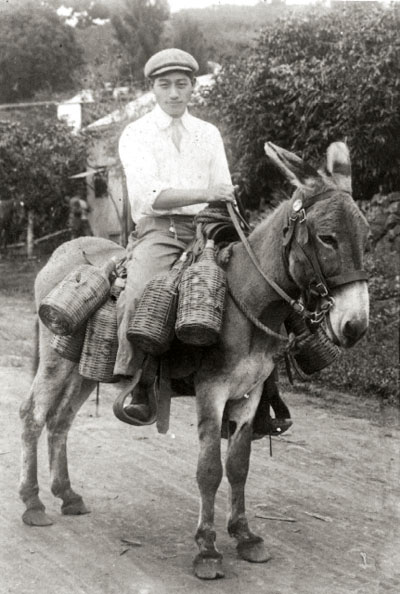 Kimura’s Lauhala Shop, opened in 1914, is a perfect example. Like other stores, Kimura’s took coffee for payment and offered a broad range of general merchandise, in addition to lauhala hats, which were a staple for the coffee farmers and field workers who shopped in their store. During World War II, when the military set up camp at a defunct sugar mill, Kimura’s found a new market for a wide range of lauhala souvenirs and other natural fiber products.
Kimura’s Lauhala Shop, opened in 1914, is a perfect example. Like other stores, Kimura’s took coffee for payment and offered a broad range of general merchandise, in addition to lauhala hats, which were a staple for the coffee farmers and field workers who shopped in their store. During World War II, when the military set up camp at a defunct sugar mill, Kimura’s found a new market for a wide range of lauhala souvenirs and other natural fiber products.
Komo Store, opened in 1920 north of Holualoa, is another fine example of one of the oldest operating general merchandise stores in North Kona. These two stores, along with the many other shops in operation for more than 50 years, were honored by two preservation groups, the Kona Historical Society and Pulama Ia Kona Heritage Corridor, as “Heritage Stores.” Look for the bronze plaques marking these establishments as you enter.
What became known as Holualoa’s “art-volution” began in 1965 when Bob and Carol Rogers converted what had initially been the Aungst Garage (c. 1900), and later the Onaka Coffee Mill (c. 1935), into the Kona Art Center. Art galleries soon followed, and today, Holualoa has become a treasured destination for those seeking local fine art. Among the treasures to be found are paintings, prints, sculptures, ceramics, stunning wooden bowls, decorated ipu (gourds) and ‘ukuleles made from Hawaii’s indigenous and other exotic woods in the village galleries [see story on page 29]. ❖
For more information: www.holualoahawaii.com
Email Ann C. Peterson at anncinzi@gmail.com.
